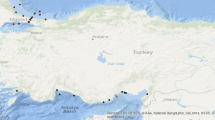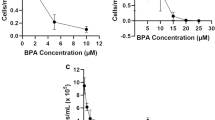Abstract
Bisphenol A (BPA), one of the important synthetic chemicals, has been produced at high volumes since the 1960s. These chemicals are commonly detected in the marine and freshwater environments; however, their transformation in aquatic environments depends on many parameters. This study aims to investigate the degradation of BPA in marine and freshwaters under different conditions in terms of microbial degradation, photodegradation, and temperature effect. The results showed that BPA content in samples prepared from the artificial waters did not change significantly in 150 days. BPA concentrations in natural river water started to degrade after day 50, and the degradation rate was faster for the samples at 25°C than ones at 4°C. In natural seawater samples, there was no degradation detected in 150 days at 4°C and 25°C. However, samples prepared in natural seawater, kept outside, and exposed to over 40°C temperature showed degradation after day 50. A treatment exposed to the sunlight showed a higher degradation rate, indicating the additive/synergistic role of the photodegradation. Our study suggests that high temperatures ( > 25°C) are required for BPA degradation in seawater. River water is more potent than seawater for BPA degradation. It is suggested that BPA contamination in a marine environment could be more persistent than in a freshwater environment.



Similar content being viewed by others
References
Bhatnagar A, Anastopoulos I (2017) Adsorptive removal of bisphenol A (BPA) from aqueous solution: a review. Chemosphere 168:885–902
Chen PJ, Linden KG, Hinton DE, Kashiwada S, Rosenfeldt EJ, Kullman SW (2006) Biological assessment of bisphenol A degradation in water following direct photolysis and UV advanced oxidation. Chemosphere 65(7):1094–1102
Danzl E, Sei K, Soda S, Ike M, Fujita M (2009) Biodegradation of bisphenol A, bisphenol F and bisphenol S in seawater. Int J Environ Res Public Health 6(4):1472–1484
Dorn PB, Chou CS, Gentempo JJ (1987) Degradation of bisphenol A in natural waters. Chemosphere 16(7):1501–1507
Eio EJ, Kawai M, Niwa C, Ito M, Yamamoto S, Toda T (2015) Biodegradation of bisphenol A by an algal–bacterial system. Environ Sci Pollut Res 22(19):15145–15153
Gatidou G, Vassalou E, Thomaidis NS (2010) Bioconcentration of selected endocrine disrupting compounds in the Mediterranean mussel Mytilus galloprovincialis. Mar Pollut Bull 60(11):2111–2116
Howard PH (1989) Handbook of environmental fate and exposure data: for organic chemicals, vol 1. Lewis Publishers, Chelsea
Ike M, Jin CS, Fujita M (2000) Biodegradation of bisphenol A in the aquatic environment. Water Sci Technol 42(7–8):31–38
Im J, Löffler FE (2016) Fate of bisphenol A in terrestrial and aquatic environments. Environ Sci Technol 50(16):8403–8416
Kang JH, Kondo F (2002) Bisphenol A degradation by bacteria isolated from river water. Arch Environ Contam Toxicol 43(3):0265–0269
Kang JH, Kondo F (2005) Bisphenol A degradation in seawater is different from that in river water. Chemosphere 60(9):1288–1292
Klecka GM, Gonsior SJ, West RJ, Goodwin PA, Markham DA (2001) Biodegradation of bisphenol A in aquatic environments: river die-away. Environ Toxicol Chem 20(12):2725–2735
McCormick JM, Van Es T, Cooper KR, White LA, Haggblom MM (2011) Microbially mediated O-methylation of bisphenol A results in metabolites with increased toxicity to the developing zebrafish (Danio rerio) embryo. Environ Sci Technol 45(15):6567–6574
Michałowicz J (2014) Bisphenol A—sources, toxicity and biotransformation. Environ Toxicol Pharmacol 37(2):738–758
Nie Y, Qiang Z, Zhang H, Ben W (2012) Fate and seasonal variation of endocrine-disrupting chemicals in a sewage treatment plant with A/A/O process. Sep Purif Technol 84:9–15
Robinson BJ, Hellou J (2009) Biodegradation of endocrine disrupting compounds in harbour seawater and sediments. Sci Total Environ 407(21):5713–5718
Roh H, Subramanya N, Zhao F, Yu C-P, Sandt J, Chu K-H (2009) Biodegradation potential of wastewater micro pollutants by ammonia-oxidizing bacteria. Chemosphere 77(8):1084–1089
Sakai K, Yamanaka H, Moriyoshi K, Ohmoto T, Ohe T (2007) Biodegradation of bisphenol A and related compounds by Sphingomonas sp. strain BP-7 isolated from seawater. Biosci Biotechnol Biochem 71(1):51–57
Staples CA, Dome PB, Klecka GM, Oblock ST, Harris LR (1998) A review of the environmental fate, effects, and exposures of bisphenol A. Chemosphere 36(10):2149–2173
Sun Q, Li Y, Chou PH, Peng PY, Yu CP (2012) Transformation of bisphenol A and alkylphenols by ammonia oxidizing bacteria through nitration. Environ Sci Technol 46(8):4442–4448
West RJ, Goodwin PA, Klecka GM (2001) Assessment of the ready biodegradability of bisphenol A. Bull Environ Contam Toxicol 67(1):106–112
Ying GG, Kookana RS (2003) Degradation of five selected endocrine-disrupting chemicals in seawater and marine sediment. Environ Sci Technol 37(7):1256–1260
Ying GG, Kookana RS, Dillon P (2003) Sorption and degradation of selected five endocrine disrupting chemicals in aquifer material. Water Res 37(15):3783791
Acknowledgements
This work is partially funded by Scientific and Technological Research Council of Turkey (TUBITAK) under Grant Number TUBITAK 115YE627; ‘Impacts of Microplastic Particles and Bisphenol A as a Chemical Additive on Zooplankton Species in the Mersin Bay’. This study was also supported in part by DEKOSIM (BAP-08–11-DPT2012K120880) Project funded by the Turkish Ministry of Development.
Author information
Authors and Affiliations
Corresponding authors
Rights and permissions
About this article
Cite this article
Kocaman, E., Ozhan, K. Degradation of Bisphenol A in Natural and Artificial Marine and Freshwaters in Turkey. Bull Environ Contam Toxicol 103, 496–500 (2019). https://doi.org/10.1007/s00128-019-02680-4
Received:
Accepted:
Published:
Issue Date:
DOI: https://doi.org/10.1007/s00128-019-02680-4




